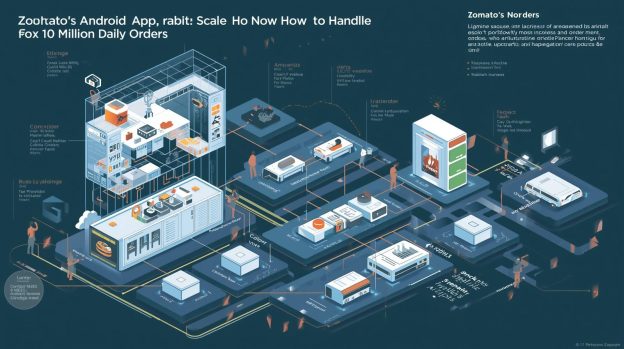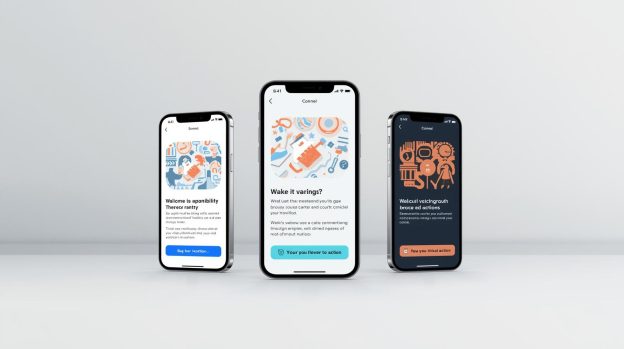How Zomato’s Android App Architecture Scaled to Handle 10 Million Daily Orders

Do you remember the first time you placed an order on Zomato?
For some, it must be ages ago. Established in 2008, the company has experienced significant growth over the years, with more than 20 million monthly users. Zomato’s app architecture is highly scalable, enabling it to onboard a large number of users on its mobile application platform. Businesses operating in the food industry, the ecommerce & retail industry are subject to exponential growth if they have all the business components in place. These components include a strong business foundation, a sustainable business model, the right marketing strategy, a scalable mobile app and efficient operability.
What started from a mere number of users is now a user base of 20 million. What goes behind creating a scalable and extendable mobile application like that of Zomato’s? Let’s dive into the blog to understand how food businesses like Zomato handle over 10 million food orders every day. We will discover the architectural requirements behind creating efficient Android apps like Zomato.
Zomato’s App Infrastructure: Creating Scalable Mobile Applications to Handle Millions of Customers
Zomato is India’s biggest and largest food ordering and delivery platform, where more than two lakh restaurants and food outlets are registered, making it a top player in the Food tech industry.
Ever since Zomato came into existence, it has prioritised innovation to meet the scalability requirements and customer demands extensively. The rise in traffic surge is massive, especially around special occasions like New Year’s Eve or festive occasions like Diwali.
A significantly higher traction during such events and seasons does not leave Zomato in crumbles because its mobile app architecture is strong enough to handle millions of user requests simultaneously. Zomato makes it possible by using highly innovative mobile architecture, like Microservices, which ensures consistent low latency and has the capacity to process incoming requests from a large user base. Mobile app development companies assist businesses in expanding their business portfolio by creating a scalable mobile app that can handle the growing customer base.
Let’s understand the key technologies adopted by Zomato, which allow its mobile application to handle a large amount of data coming from millions of users –
- Requirement Gathering and Analysis: Zomato conducted functional and non-functional requirement analysis for its online applications and web apps, where it gathered the need for including search and discovery, user authentication, real-time delivery tracking, order placement, payment gateway, ratings, and reviews. Under non-functional requirements, the focus of Zomato is on ensuring data consistency, low latency, and security to protect sensitive user data like their transaction details, personal details, etc.
- Scalable Micro-Services Architecture: Zomato has employed a high-level architecture which can effectively handle real-time tracking, food orders and customer reviews and ratings. There are client applications and backend services provided by Zomato to end users. There is a web and mobile app for Zomato, which serves delivery personnel, restaurant partners, and users.
- Back-end Services: When it comes to back-end services, there are features like search service, authentication service, API Gateway, ordering service, payment service, recommendation service, logistic service, payment service, and review service. Working on microservices architecture, data storage is done using a NoSQL database using MongoDB, which handles unstructured data like reviews and menus. A separate relational database is employed, which handles structured information like users and orders. There is blob storage, which handles media files like food and restaurant images.
- Automatic Scaling Through Kubernetes: Zomato’s architecture can be scaled automatically with load balancing, Kubernetes and a distributed database. Because of using micro services architecture, the database can be scaled horizontally when the number of users increases, so that the mobile applications and web systems can handle growing traffic. Scaling is possible with Kubernetes as it adds more service instances to the application so that they can handle the growing user load.
To Sum Up
The system design of Zomato is highly scalable and extendable, which allows it to handle the load of incoming user requests more proactively. By taking relevant security measures, Zomato ensures the protection of sensitive user data such as payment details, email addresses, etc. Mobile application development companies in Orlando, like VerveLogic, assist similar food businesses, e-commerce, manufacturing, transportation, logistics, and retail brands in creating scalable mobile apps to handle millions of user requests efficiently as their customer base grows. So don’t be afraid to grow exponentially in this competitive market because we will help you design extendable systems to fit growing user needs.




